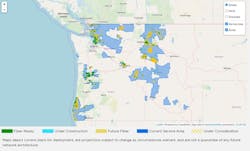BCE took another step forward to fulfill its desire to penetrate U.S. fiber broadband with the FCC’s approval of its pending acquisition of Ziply Fiber.
The roughly $5 billion deal ($3.6 billion in cash and $1.44 billion of debt) officially marks BCE's entrance into the US fiber market.
In its ruling about the acquisition, the FCC said that BCE’s acquisition will not create competitive challenges because Bell Canada and Ziply Fiber have no geographic overlap in their operating territories.
“Based on the current record, we find that there are no likely potential transaction-related public interest harms,” wrote the FCC in its ruling. “First, we find that the proposed transaction will not result in a reduction of competition.”
Another key factor is that existing Ziply customers will see a consistent experience.
The FCC said that the applicants explained that “Bell Canada intends for the Ziply Fiber business to continue as its operating entity, maintaining its existing company management and business plan,” and the proposed transaction will be seamless, transparent, and “will not result in any disruptions to Ziply Fiber customers or business partners.”
Further, as a result of the proposed acquisition, “Bell Canada will bring its fiber deployment expertise to bear to help Ziply Fiber meet its fiber buildout plans and address challenges in deploying fiber in geographically difficult locations.”
U.S. fiber potential
BCE sees the growing potential in the U.S. fiber broadband market.
Mirko Bibic, President and CEO of BCE, told investors during the company's first-quarter earnings call that BCE sees opportunities for growth in the U.S. fiber broadband market.
“The U.S. has attractive fiber economics with a low cost to build and strong ARPU growth,” he said. “Importantly, like in Canada, U.S. customers are choosing fiber.”
He called the US "a natural expansion market for BCE, where we can leverage our deep expertise in building fiber infrastructure."
Within Ziply’s market, Bibic noted that the “market structure is even more attractive for Ziply.”
“Household income and economic growth across its four states in the Pacific Northwest is above the national average,” he said. “There are one or fewer gigabit-capable competitors in 93% of Ziply Fiber’s operating footprint, no multi-gig capable competitors, and relatively less overbuilding activity in the Pacific Northwest than in some other U.S. regions.”
A key focus for BCE and its equity partner, PSP Investments, which will hold a 51% stake in the venture, is to expand last-mile fiber in Ziply’s growth markets. This will include the build-out of approximately 1 million fiber passings in Ziply's existing states, with the ability to expand to 6 million fiber locations longer term.
Bibic said this will enable Ziply to extend its service even further than initially planned.
“This will enable Ziply to eventually reach up to 8 million total fiber locations, an increase from its original target of 3 million,” he said. “The strategic partnership structure is a cost-effective and capital-efficient way to fund our U.S. fiber growth while still meeting our deleveraging targets.”
Fiber rising
BCE’s Ziply acquisition reflects the growing opportunities in the U.S. fiber market.
A new Fiber Broadband Association Fiber Deployment survey, conducted in collaboration with RVA Market Research & Consulting (RVA), revealed that fiber broadband deployments reached a new annual record of 10.3 million U.S. homes passed in 2024.
The 2024 survey data suggests that fiber now passes 56.5% of U.S. households. Fiber take rates increased slightly in 2024, growing to an average of over 45% based on unique passings. Service providers are achieving their first 20% take rate much faster and reaching higher take rates over time.
Looking at the 2025-2029 period, we can see a more than 50% increase in homes passed and a more than 100% increase in route miles to support these homes.
A growing M&A wave
BCE’s pending acquisition of Ziply appears to reflect a growing M&A wave in the fiber broadband market.
This wave is being led by Tier 1 telcos AT&T and Verizon. AT&T is moving to acquire Lumen’s FTTH business, while Verizon is going to acquire Frontier. Each of these deals will significantly expand these Tier 1 fiber footprints.
However, Tier 1 providers aren’t the only ones making acquisition moves.
Consolidation in the regional fiber broadband market is expected to continue accelerating over the next year. According to a survey conducted by AlixPartners last fall, more than 400 small fiber providers in the U.S. “are ripe for picking by investors or larger fiber companies when the inevitable major fiber consolidation wave occurs.”
AlixPartners estimates that there are approximately 1,900 small-scale fiber companies in the U.S., with about 1,000 of these companies being either electric co-ops or affiliated with more prominent energy players.
AlixPartners estimates that roughly 400 of the remaining 900 small-scale fiber companies are meaningful candidates for mergers and acquisitions.
In recent months, other regional players, including Brightspeed, Greenlight Networks, and Hillary Communications, have been making moves to acquire other regional assets, thereby expanding their respective addressable markets.
Brightspeed reached a deal to acquire Cincinnati Communications’ fiber network, which will add nearly 70,000 premises in Butler and Hamilton Counties. Meanwhile, Greenlight is expanding its power in Pennsylvania by acquiring Loop Internet, and Hillary is acquiring TDS Telecom's Oklahoma network operations in a bid to enhance fiber broadband in rural markets.
For related articles, visit the Broadband Topic Center.
For more information on high-speed transmission systems and suppliers, visit the Lightwave Buyer’s Guide.
To stay abreast of fiber network deployments, subscribe to Lightwave’s Service Providers and Datacom/Data Center newsletters.
About the Author
Sean Buckley
Sean is responsible for establishing and executing the editorial strategy of Lightwave across its website, email newsletters, events, and other information products.



